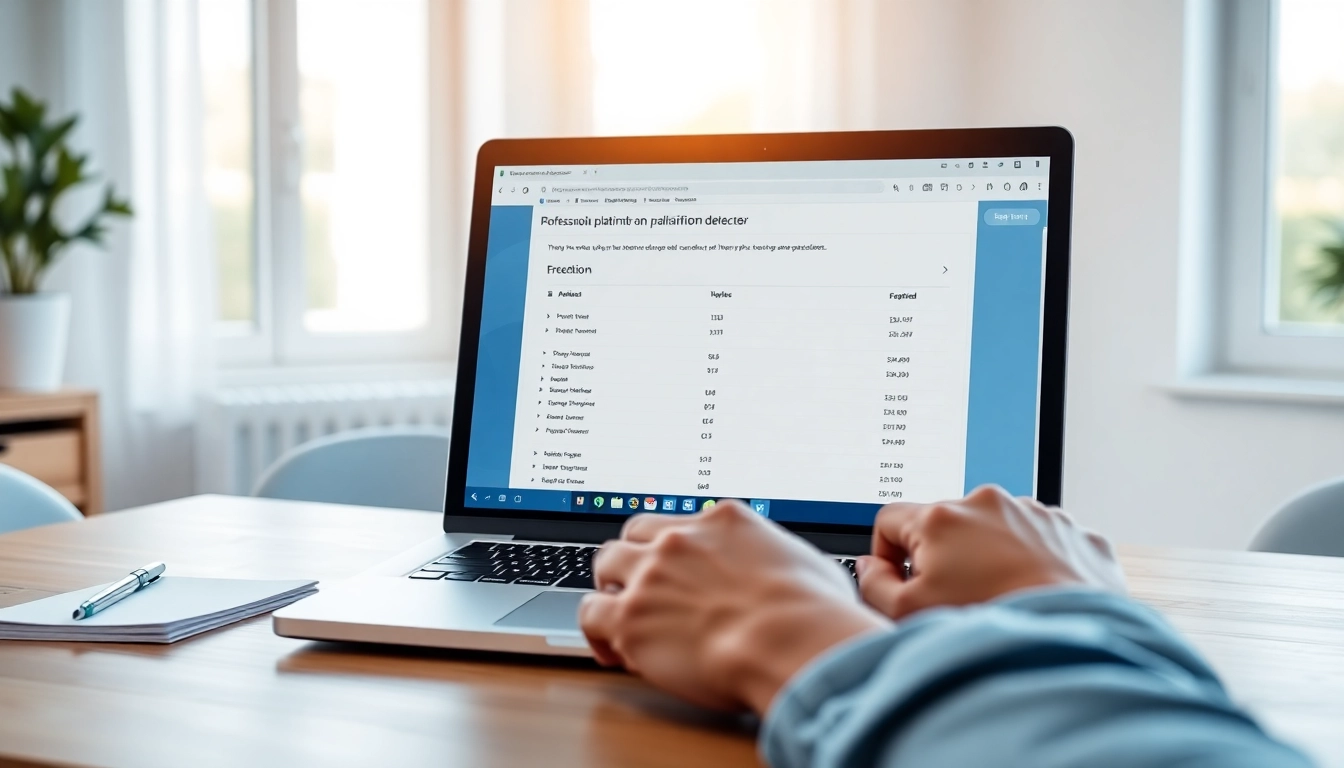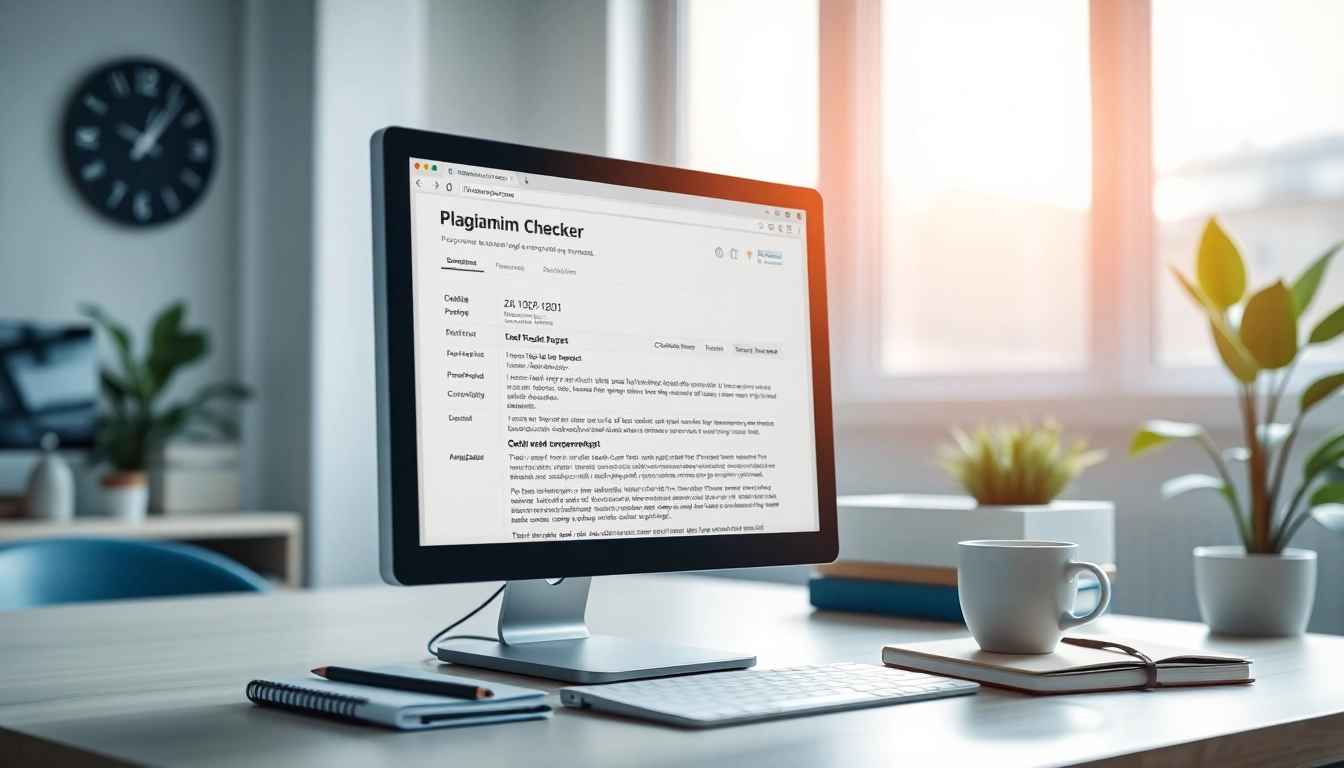Understanding Plagiarism Detection
In today’s information-driven world, the ability to produce original content is of paramount importance, especially in academic and professional circles. As barriers to accessing information have diminished, the risk of unintentional plagiarism has increased. This has given rise to the development of advanced plagiarism detector tools that help users safeguard their work and uphold academic integrity.
What is a Plagiarism Detector?
A plagiarism detector is a specialized software tool designed to identify instances of copied text or uncredited ideas in written works. These tools analyze submissions against a vast database of published materials, including academic papers, websites, and previously submitted essays. By comparing the text in question with these sources, a plagiarism detector can highlight similarities and flag potential issues of originality.
How Plagiarism Detectors Work
Plagiarism detection occurs primarily through two methodologies: algorithmic comparison and semantic analysis. The most common approach involves textual matching, where the tool scans submitted content for exact phrases and sentences that resemble other sources. However, the more advanced detectors employ semantic analysis, which evaluates the context and meaning of the text, allowing them to detect paraphrased content and ideas expressed in different formats.
When a document is submitted, the detector creates a fingerprint of the text and compiles it into a format that can be matched against its database. This exhaustive scanning process can reveal not only direct copying but also instances of insufficient citation or improper paraphrasing.
The Importance of Using a Plagiarism Detector
The necessity of using a plagiarism detector cannot be overstated. First and foremost, it helps maintain academic integrity by ensuring that writers properly attribute sources and avoid unintentional copyright infringement. For students, this means protecting their grades and reputations; for professionals, it means safeguarding their credibility and career prospects.
Furthermore, plagiarism detectors serve as educational tools. By reviewing the reports generated from these tools, users can identify areas where they may need to improve their writing skills, citation practices, and overall originality.
Choosing the Right Plagiarism Detector
With a plethora of plagiarism detection tools available, selecting the right one can be overwhelming. It’s essential to consider various factors, including accuracy, database size, usability, and cost. This section outlines key features to look for, compares free and paid options, and reviews some top tools in the market.
Key Features to Look For
- Database Scope: A wide-ranging database increases the likelihood of detecting plagiarism, including academic journals, publications, and web content.
- Real-Time Comparison: Tools that compare text in real time provide immediate feedback, allowing users to make necessary adjustments promptly.
- Detailed Reporting: Look for tools that offer comprehensive reports, highlighting areas of concern and suggesting proper citation formats.
- User-Friendly Interface: Tools should be intuitive and easy to navigate, catering to users of varying technical skills.
- Multiple File Format Support: The detector should accept various file types, making it versatile for different user needs.
- Cost-Effectiveness: Evaluate pricing structures to ensure you receive valuable features without overpaying.
Comparing Free vs Paid Plagiarism Detectors
Free plagiarism detectors often serve as a good starting point for casual users or students on a tight budget. However, they typically offer limited databases and fewer features compared to their paid counterparts. Paid plagiarism detection services usually provide more robust features, including advanced text analysis, priority support, and access to broader databases, making them ideal for serious writers, academics, and professionals.
When deciding between free and paid options, consider assessing your individual needs. If you frequently produce written content that demands high levels of originality, investing in a reliable paid plagiarism detector can save you time and protect your reputation.
Top Plagiarism Detector Tools Reviewed
Here are some of the leading plagiarism detection tools:
- Grammarly: Known for its writing enhancement capabilities, Grammarly also features a robust plagiarism detection system leveraging an extensive database to ensure your content’s originality.
- Scribbr: Renowned for its accuracy, Scribbr’s plagiarism checker offers detailed reports and is favored by students and academic professionals alike.
- DupliChecker: This free tool delivers an uncomplicated interface while providing effective plagiarism detection for basic needs.
- Copyleaks: A richer feature set supports multiple file types and AI-powered detection, making it popular among education and content creation sectors.
- Turnitin: Widely used in academia, Turnitin provides comprehensive reports, including grading and feedback options.
Implementing a Plagiarism Detector in Your Workflow
Once you’ve selected a plagiarism detector, effectively incorporating it into your writing process can enhance the quality of your work significantly. This section will guide you through simpler steps, common pitfalls, and practical best practices for utilizing these tools effectively.
Step-by-Step Guide to Using a Plagiarism Detector
- Choose Your Detector: Select the plagiarism detector that best fits your needs based on the comparisons made earlier.
- Prepare Your Document: Ensure your text is polished and organized before submission. This allows for a more effective plagiarism scan.
- Upload Your Content: Follow the platform instructions to upload your text, ensuring you select the correct file format if applicable.
- Review the Report: Once the scan is complete, carefully review the report generated, paying close attention to highlighted sections.
- Make Necessary Edits: Use the feedback provided to rework portions of your text where plagiarism was detected, ensuring proper citation.
- Re-scan if Necessary: For major revisions, it may be wise to run the text through the detector again to confirm that issues have been resolved.
Common Mistakes to Avoid
- Neglecting to Check Properly: Failing to utilize a plagiarism detector before submission can lead to academic or professional penalties.
- Ignoring the Report: Simply glossing over the feedback can mean missing critical learning opportunities to enhance your writing.
- Over-reliance on Tools: While advanced tools are helpful, they should complement your judgment and writing skills rather than replace them entirely.
Best Practices for Effective Use
- Use Early and Often: Integrate plagiarism checks into your writing process to catch issues early and avoid last-minute problems.
- Understand the Reports: Take time to interpret the plagiarism reports thoroughly; know what constitutes plagiarism and how to address it.
- Consider Paraphrasing: When similarities arise, consider rephrasing or synthesizing information rather than making small edits to avoid detection.
Improving Your Writing with a Plagiarism Detector
Effective use of a plagiarism detector does not end with merely avoiding plagiarism; it can also serve as a tool for enhancing your writing quality overall. This section delves into how you can analyze reports, learn from feedback, and improve your originality.
How to Analyze Reports from a Plagiarism Detector
Understanding the results of a plagiarism check is crucial in recognizing which parts of your work may need further attention. Reports typically show the percentage of similarity and highlight specific sections of text that match other sources. Take the time to revisit these segments, consider their context in your work, and decide the best approach to rectify any potential issues.
Learning From Plagiarism Feedback
Feedback from plagiarism detection tools provides a unique opportunity for personal growth as a writer. As you receive reports over time, look for patterns of repeated mistakes. Whether it’s a specific citation style or a tendency to inadvertently paraphrase too closely, recognizing these patterns is the first step to improving your writing skills.
Enhancing Originality in Your Writing
Being original is not solely about avoiding plagiarism; it involves critical thinking, creativity, and a personal voice. Engage actively with your sources: synthesize varied ideas and concepts; provide your insights and opinions on topics, and foster your perspective. Over time, as you cultivate your authentic writing style, you’ll find that plagiarism detection becomes less about avoiding pitfalls and more about elevating your craft.
The Future of Plagiarism Detection
As technology evolves, so too do the methods for detecting plagiarism. This section examines the emerging trends, the role of artificial intelligence, and important ethical considerations surrounding plagiarism detection.
Trends in Plagiarism Detection Technology
New developments within plagiarism detection are focused on enhancing accuracy and efficiency. Emerging trends include the integration of machine learning algorithms that can improve semantic analysis capabilities. These advancements allow plagiarism detectors to identify subtle forms of plagiarism that traditional tools may overlook.
Additionally, with an increase in diverse content types, including multimedia works, plagiarism detection is evolving to include checks for visual and audio content, taking a holistic approach to content integrity education.
The Role of AI in Plagiarism Detection
Artificial intelligence plays a significant role in modern plagiarism detectors. AI-enhanced tools use sophisticated algorithms to compare texts not just for verbatim matches but for contextual understanding, enabling them to detect paraphrased materials and improved recognition of AI-generated content.
As AI technology progresses, these detectors will likely become even more intuitive, providing comprehensive insights pertinent to both originality and quality of writing.
Ethical Considerations in Plagiarism Detection
As tools for detecting plagiarism continue to evolve, so do the ethical implications surrounding their use. Educators must balance promoting academic integrity while ensuring that students understand the significance of originality rather than simply fearing penalties for cheating. It’s crucial to foster a culture that encourages ethical writing habits rather than solely relying on detection tools as guardians against misconduct.
In addition, careful consideration must be given to the data privacy of users, as some tools may store submitted content for future use or analysis. Transparency regarding data usage policies allows users to make informed decisions about their writing practices.



